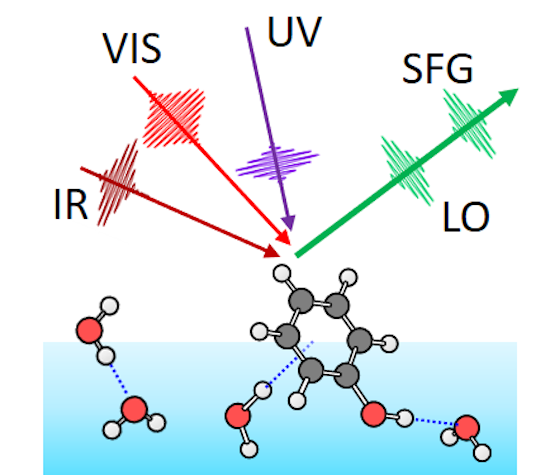Feb. 15, 2021 Press Release Chemistry
The water surface is a fantastic place for chemical reactions
Using an advanced technique, scientists from the RIKEN Cluster for Pioneering Research have demonstrated that a chemical reaction powered by light takes place ten thousand times faster at the air-water interface—what we usually call the water surface—than in the bulk of the water, even when the light has equivalent energy. This finding could help our understanding of the many important chemical and biological processes that take place at the water surface.
Water is the most important liquid in nature, and research has shown that there is in fact something special about the interface. For reasons that were not well understood, it appears that some chemical reactions take place readily when the molecules are partly in the water, but not when they are fully dissolved.
One issue hampering understanding is that how chemical reactions actually proceed at the interface is not well understood. To investigate this, the RIKEN group used an advanced technique called ultra-fast phase-sensitive interface-selective vibrational spectroscopy. It’s a mouthful, but essentially it means that you can get a high-speed movie of the intermediate molecules created as a chemical reaction takes place at an interface. In this case, “high-speed” means about one hundred femtoseconds, or less than a trillionth of a second.
Using the method, they analyzed the photoionization of phenol, a reaction that has been well studied in bulk water, using equivalent high-speed pulses of ultraviolet light. The experiments showed that the same reaction took place at the interface but that due to differences in the conditions there, the reaction took place roughly ten thousand times faster.
According to Satoshi Nihonyanagi, one of the authors of the study, published in Nature Chemistry, “It was exciting to find that the reaction speed for phenol is so phenomenally different, but in addition, our method for directly observing chemical reactions at the water surface in real time could also be applied to other reactions, and could help us get a better understanding of how reactions proceeds in this special environment.”
According to Tahei Tahara, the leader of the research group, “The fact that the there is a 10,000-fold difference in the reaction rate of a basic organic molecule such as phenol between the bulk water and the water surface is also very important for catalytic chemistry, the field of study that aims to promote and control chemical reactions. IN addition, water in nature exists as seawater, which has bubbles and aerosols, thus having a vast surface area. Our work could help us to understand how molecules are adsorbed on the surface of water, leading to chemical reactions that have an enormous impact on the global environment.”
Reference
Contact
Tahei Tahara, Chief Scientist
Molecular Spectroscopy Laboratory
RIKEN Cluster for Pioneering Research
Satoshi Nihonyanagi, Senior Research Scientist
Molecular Spectroscopy Laboratory
RIKEN Cluster for Pioneering Research
Jens Wilkinson
RIKEN International Affairs Division
Tel: +81-(0)48-462-1225 / Fax: +81-(0)48-463-3687
Email: pr [at] riken.jp

Illustration of the sample interface
